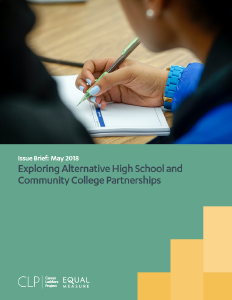This Issue Brief provides a candid look at the practices and operational realities of supporting opportunity youth and alternative high school students in preparation for college and the workplace.
In California, “alternative school” refers to a school that provides a nontraditional educational setting for students who are at risk because they have dropped out, are pregnant or parenting, exhibit behavior issues, or need a different schedule to accommodate outside work. While these investments are critical in supporting students’ educational and career success, the needs of opportunity youth —young people ages 16–24 who have been pushed out, have dropped out, or are disconnected from education or careers—and the needs of alternative school students, families, and staff, largely remain absent from these reform efforts.
The intent of this Brief is twofold:
- To present a conceptual framework to help practitioners, administrators, and others understand what constitutes high-quality transitions from alternative high school to community college (Section 1); and
- To elevate emerging practices and common implementation considerations for efforts designed to meet the unique skills and needs of alternative high school students as they transition between alternative high schools into community college and careers (Section 2).
